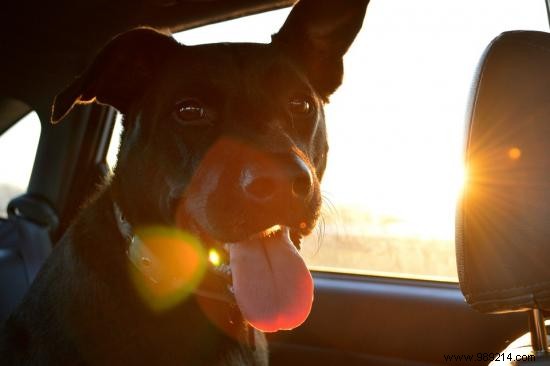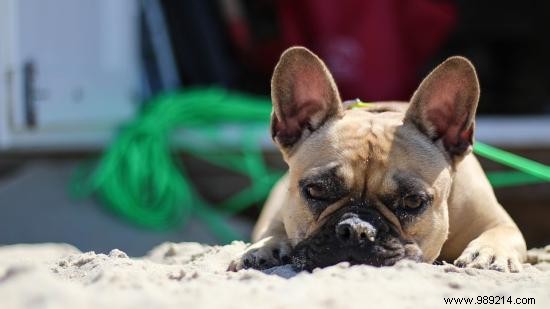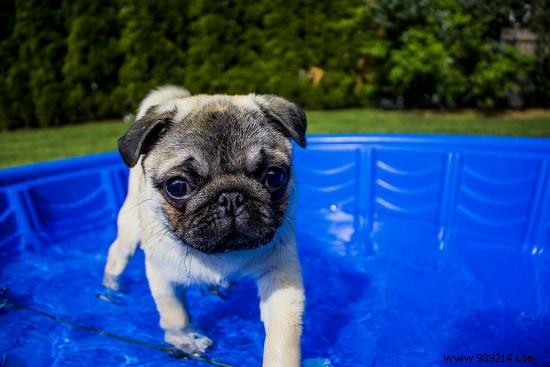
The heat wave is setting in.
You're hot ? You are not the only one ! So does your dog.
We too often forget that dogs are very sensitive to rising temperatures.
It is therefore necessary to protect them as best as possible. Humans can preserve themselves from the heat by various ingenious systems. But the dogs are helpless without our help.
To cope, they can only rely on their organism. And sometimes that's not enough.
In a context of high heat, without our intervention, there is a high risk of heat stroke. And our four-legged friend might not survive it.
The best way to avoid this drama is to recognize the symptoms of heatstroke and apply some essential tips to protect it.

- Your dog's behavior has changed:he is usually dynamic, and there he is all over again. Or he is gentle as a lamb and he shows signs of aggression. Also note that it can be very agitated and not stay in place.
- His body temperature increases considerably.
Note: a dog's normal temperature is 38.5°C with normal variations between 38°C and 39°C. So you have to worry when it is above 39°C. The danger is real if its temperature exceeds 40°C.
- His breathing is irregular and rapid. He is panting loudly.
- His nose is hot.
- His tongue and lips have a bluish color.
- He's shaking.
- He feels dizzy.
- He salivates a lot or his mouth foams.
- He may be vomiting.
- The frequency of his heartbeat increases.
If your dog has one or more of these symptoms, and it is very hot, he is probably the victim of heatstroke .
Certain factors will contribute to the occurrence of these symptoms. Knowing them will allow you to react in time or to better interpret the symptoms that we have just described.

- Your dog did not drink enough water.
- He takes medicine.
- He is overweight.
- He is not used to a hot climate.
- He remained confined in an unventilated space. Be careful, staying in a ventilated space, but with air conditioning is also a factor that will promote heat stroke in your dog.
- It has been hot for several consecutive days and nights.
- He stayed in the sun too long.
- He had intense physical activity.
If you suspect your dog is hyperthermic, do not leave him unattended.
Keep your pet cool, place a damp cloth or blanket over their neck and back.
Call your veterinarian immediately and schedule an appointment.
What not to do:
Do not put it in very cold water and do not use ice. It may cool down too quickly.
Don't force him to drink. Offer him water:if he wants to drink, he will take the initiative.
We agree:the best thing is to avoid this kind of emergency. To prevent your dog from overheating, you should take a few simple precautions.
Applying these simple gestures will prevent your dog from overheating to the point of feeling unwell.

Every summer, dog owners leave their pets in their cars while they run errands.
Why?
Alas, the temperature rises very quickly in the passenger compartment of a car in the sun. Your car quickly turns into a rotisserie. And it only takes a few minutes for your dog to become dehydrated.
What to do?
- Simply leave your dog at home before going shopping. Put it in a room as cool as possible or well ventilated.
Make sure he always has water available.
If you leave it in your garden, make sure there is always a shady spot where it can take refuge. Even if the sun turns!
- Can't leave your dog at home? Take it in your car, but park it in the shade. And leave him under the supervision of another person who can give him something to drink if necessary.
What you should NEVER do
Never leave your dog ALONE whether your car is in the shade or not:
- Even if you leave the window open.
- Even if you leave the air conditioning on, because a breakdown is never safe.
What is valid for you is also valid for your dog:no effort in hot weather. Do not exercise your dog in very hot weather. He is at risk of heat stroke.
If you want him to exercise, it's in the morning before 10 a.m. or in the evening after 6 p.m.
Even with these precautions, it is better to stay in the shade and not force it too much.

If your dog walks on hot asphalt or hot sand, he can burn his paw pads!
Discover our simple trick to know if the ground is too hot to take your dog out.
Even more than usual!
When it's hot, make sure your dog always has fresh water to drink. Including while on the move. Remember to take a water bottle or a bottle especially for your 4-legged friend.

Yes, your dog can get sunburn too! It is sensitive to bad UV rays. If you stop with him in the sun, during a picnic or on the beach, you have to think about protecting your dog not only from the heat but also from UV rays!
Put sunshades on the back window of your car. On the beach, an anti-UV solar tent will do the trick.
Always with water of course!
Driving in the cool will be more pleasant for you… and for your dog!
If you can't help but drive in the middle of the afternoon, consider equipping your car with a sun visor and turn on the air conditioning!
Take regular breaks on the road so he can drink and relieve himself.

When it's hot, the first instinct is often to wet your dog completely with ice cold water.
This is not necessarily a very good idea:because the sudden difference between hot and cold can cause a thermal shock.
To lower your dog's body temperature, it is better to:
- pass a damp glove over the coat, insisting on the head, neck, under the belly and inside the thighs. You can simply use the flat of your moistened hand to do the same.
- Do you have a water mister at home? Your dog will love it! Use it to refresh it.
- You can use a cooling vest specially designed for your Fido! Just soak it in water for 3 minutes and put it on your dog. Here it is chilled for several hours!
What you should NEVER do:
Do not put your dog under icy water (bathtub, water jet…):check beforehand that the water is not too cold.
And there you have it, with these 7 simple tips, you are sure to keep your dog healthy despite the heat.
Keep in mind that some dogs are more sensitive to heat. These are puppies and old dogs, but also all dogs with a 'flattened' muzzle (bulldog, boxer, etc.). Their breathing is more difficult!